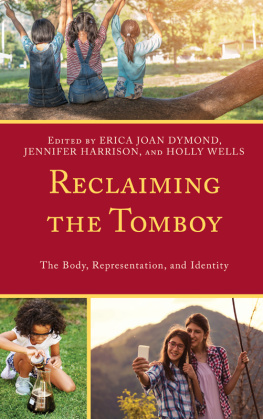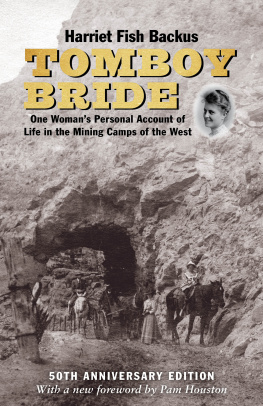Contents
Guide

Reclaiming the Tomboy
Reclaiming the Tomboy
The Body, Representation, and Identity
Edited by Erica Joan Dymond, Jennifer Harrison, and Holly Wells
LEXINGTON BOOKS
Lanham Boulder New York London
Published by Lexington Books
An imprint of The Rowman & Littlefield Publishing Group, Inc.
4501 Forbes Boulevard, Suite 200, Lanham, Maryland 20706
www.rowman.com
86-90 Paul Street, London, EC2A 4NE
Copyright 2022 by The Rowman & Littlefield Publishing Group, Inc.
copyright 2022 by Poppy Wilde
All rights reserved . No part of this book may be reproduced in any form or by any electronic or mechanical means, including information storage and retrieval systems, without written permission from the publisher, except by a reviewer who may quote passages in a review.
British Library Cataloguing in Publication Information Available
Library of Congress Cataloging-in-Publication Data
Names: Dymond, Erica Joan, editor. Title: Reclaiming the tomboy : the body, representation, and identity / edited by Erica Joan Dymond, Jennifer Harrison, and Holly Wells. Description: Lanham, Maryland : Lexington Books, [2022] | Includes bibliographical references and index. | Summary: "With the tomboy figure currently operating in a liminal space between extinction and resurgence, this collection is an unabashed celebration of her rebellious, independent, and pioneering spirit. Reclaiming the Tomboy: The Body, Identity, and Representation pays tribute to tomboys of the past, present, and (hopefully) future"-- Provided by publisher. Identifiers: LCCN 2022014847 (print) | LCCN 2022014848 (ebook) | ISBN 9781793622945 (cloth) | ISBN 9781793622952 (ebook) Subjects: LCSH: Gender identity. | Tomboys. Classification: LCC HQ1075 .R426 2022 (print) | LCC HQ1075 (ebook) | DDC 305.3--dc23/eng/20220516 LC record available at https://lccn.loc.gov/2022014847 LC ebook record available at https://lccn.loc.gov/2022014848
 The paper used in this publication meets the minimum requirements of American National Standard for Information SciencesPermanence of Paper for Printed Library Materials, ANSI/NISO Z39.48-1992.
The paper used in this publication meets the minimum requirements of American National Standard for Information SciencesPermanence of Paper for Printed Library Materials, ANSI/NISO Z39.48-1992.
Erica Joan Dymond: I would like to thank my parents, Eric D. Dymond and Joan A. Dymond, who gifted me both dresses and pants, let me play in the woods as well as with Care Bears, who paid for my skateboard as well as my watercolors, and allowed me to indulge in countless hours of violent video games as well as flower tending. Thank you for never replacing my ripped-up jeans, beloved Castlevania, or coveted Stephen King books with something gender appropriate. Thank you for letting me be my own type of tomboy. And thank you to my brother, Jason B. Dymond, who taught me how to beat the tough bosses in Mario, rode Space Mountain alongside me, and watched the entire Stranger Things series with me... again. You are the best. Finally, I would like to extend a thank you to Roland M. Nguyen who taught me to be an efficient rogue in WoW, introduced me to Hunter X Hunter, and didnt laugh when I crashed my Hoverboard. You are a glorious sounding board, friend, and partner.
Jennifer Harrison: I would like to thank my two awesome co-editors, who worked so hard to keep this project going despite the huge upheavals caused by the pandemic.
Holly Wells: Not sure thank you is the right phrase, but a shout-out to my mom, may she rest in peace, for calling me Hal when I went through my childhood transgender phase (yes, I wanted to be a boy); thanks also to my husband, Jaryl, for never expecting me to perform femininity because Im terrible at it; to my birth mother, Roberta, for being a superb role model of adult tomboyhood at 75; and to my sons, Stefan and Julian, for educating me on the appropriate modern lingo for all things, but especially things LGBTQ + related.
Half a Millennium of Tomboys and a Twenty-First Century Controversy
The word tomboy is first noted in 1556 as a way to describe boys who are extra-boisterous. Here, the first part of the word, tom-, derives from the twelfth century, Middle English variant of the word meaning boy-type (as observed in words such as tomcat, tomfool, tom turkey, etc.) ( Davis 2020 , 17). Not until the 1590s does the term evolve to refer to a wild, romping girl, [a] girl who acts like a spirited boy ( King 2017 ). This definition, for the most part, remains stable from here, as reflected in the Oxford English Dictionarys current definition (i.e., non-obsolete definition) of tomboy as a girl or young woman who acts or dresses in what is considered to be a boyish way, esp. one who likes rough or energetic activities conventionally more associated with boys (Tomboy n.d.).
While the tomboy figure, as we know her, has existed since the late sixteenth century, she begins to gain genuine prominence in the first half of the 1800s. By the late 1880s, this figure is ubiquitous in the United States. What distinguishes these adult tomboys from their predecessors is their purpose. Many are among the middle-and upper-class women fighting for gender equalityspecifically, the right to vote. At this point, the tomboy figure becomes closely tied to first-wave feminism, an association that continues into the early twentieth century ( King 2017 ).
Tomboyism as an expression of feminism is also seen in the literature of 1800s. Here, the tomboy figure begins to appear in popular American novels. Perhaps unsurprisingly, this figure is most frequently found in the work of feminist authors such as Elizabeth Stuart Phelps and Louisa May Alcott. In fact, in Tomboys: A Literary and Cultural History, scholar Michelle Ann Abate declares that it is the appeal of the topsy turvy tomboy that propelled Little Women to instant success (2008, IX X). As a result of Alcotts Jo March, by the late 1800s the tomboy becomes iconic.
Throughout the early 1900s, the tomboy continues to experience popularity in both real life and the arts. Further, in the 1950s, tomboy fashion becomes the new cool as exemplified by the carefree style of the much beloved Audrey Hepburn. A tomboy in her adolescence, Hepburn, with her signature black capri pants, inspires many to copy her style ( Gitlin 2009 , 4). Those pants become so inextricably linked to her tomboy persona that she continues to wear them both on and off screen throughout her life ( Caughran 2016 , 65). It is little wonder why Elle magazines Natasha Harding declares her The Ultimate Tomboy Style-Muse (2018).
No discussion of tomboys in Hollywood would be complete without mentioning Mary Tyler Moore. Her insistence on wearing capri pants on the Dick Van Dyke Show (19611966) led to a legendary battle with CBS in which the networks executives made Carl Reiner promise not to let [Moore] wear pants in more than one scene [per episode] ( Desta 2017 ). Desta quotes Moore as saying:
We went along with that for about three episodes, and then finally, I was just wearing the pants. We got the absolution of men everywhere and women kind of breathed a sigh of relief, too, and said, Hey, thats right. Thats what we wear.
Moores point is that women were not vacuuming their homes while wearing high heels and frilly dresses with crinolines. Thus, even though everyday women are not able to wear pants in public without social repercussions until the 1960s, Audrey Hepburn and Mary Tyler Moores tomboy fashion (along with that of early pants-adopters like Marlene Dietrich and Katherine Hepburn) helps to normalize them ( Snodgrass 2015 , 5912).












 The paper used in this publication meets the minimum requirements of American National Standard for Information SciencesPermanence of Paper for Printed Library Materials, ANSI/NISO Z39.48-1992.
The paper used in this publication meets the minimum requirements of American National Standard for Information SciencesPermanence of Paper for Printed Library Materials, ANSI/NISO Z39.48-1992.